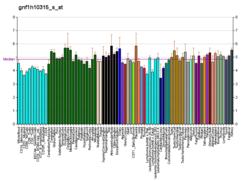프로키네틴 수용체 2 (PKR2 )는 인간의 PROKR2 유전자 에 의해 인코딩된 조광성 [5] 단백질 결합 수용체 다.[6]
함수 프로키네틱신은 혈관신생을 촉진하고 강력한 위장 매끄러운 근육수축을 유도할 수 있는 분비 단백질이다. 이 유전자에 의해 인코딩된 단백질은 프로키네틱신을 위한 일체형 막 단백질과 G 단백질 결합 수용체다. PKR은2 384개의 아미노산으로 구성되어 있다. 위치 7과 27의 아스파라긴 잔류물은 N-연계 글리코실화 를 거친다.[5] 위치 128과 208의 사이스틴 잔여물은 이황화 결합 을 형성한다.[5] 인코딩된 단백질은 프로키네틱스용 또 다른 G 단백질 결합 수용체인 GPR73과 순서가 비슷하다.[6] PKR은2 포유류 순환 리듬과도 연결된다.[7] PKR2 mRNA의 수준은 초경련핵 에서 변동하며 낮에는 증가하고 밤에는 감소한다.[7]
PROKR2 (KAL3 ) 유전자 의 돌연변이 는 저농축성 저농축성 및 자네코마스티아 에 관련되어 있다.[8] 생쥐에서 PKR이2 완전히 손실되면 대개 해질녘에 시작하여 평균 8시간 동안 지속되는 자연 발생적인 토포 현상이 발생한다.[9]
PKR은2 G단백질 결합 수용체 역할을 하므로 리간드 결합 시 신호 캐스케이드가 있다. PKR은2 Gq결합단백질이라 리간드가 결합하면 베타형 인산염 C가 활성화돼 이노시톨 3인산염 이 생성된다. 그리고 나서 이것은 세포 내부의 칼슘 방출을 촉발한다.[10]
참고 항목 참조 ^ a b c GRCh38: 앙상블 릴리스 89: ENSG00000101292 - 앙상블 , 2017년 5월^ a b c GRCm38: 앙상블 릴리스 89: ENSMUSG000050558 - 앙상블 , 2017년 5월^ "Human PubMed Reference:" . National Center for Biotechnology Information, U.S. National Library of Medicine .^ "Mouse PubMed Reference:" . National Center for Biotechnology Information, U.S. National Library of Medicine .^ a b c Sposini S, Caltabiano G, Hanyaloglu AC, Miele R (January 2015). "Identification of transmembrane domains that regulate spatial arrangements and activity of prokineticin receptor 2 dimers". Molecular and Cellular Endocrinology . 399 : 362–372. doi :10.1016/j.mce.2014.10.024 . PMID 25449422 . ^ a b "Entrez Gene: PROKR2 prokineticin receptor 2" .^ a b Masumoto KH, Nagano M, Takashima N, Hayasaka N, Hiyama H, Matsumoto S, et al. (June 2006). "Distinct localization of prokineticin 2 and prokineticin receptor 2 mRNAs in the rat suprachiasmatic nucleus". The European Journal of Neuroscience . 23 (11): 2959–2970. doi :10.1111/j.1460-9568.2006.04834.x . PMID 16819985 . ^ Narula HS, Carlson HE (November 2014). "Gynaecomastia--pathophysiology, diagnosis and treatment". Nature Reviews. Endocrinology . 10 (11): 684–698. doi :10.1038/nrendo.2014.139 . PMID 25112235 . S2CID 40159424 . ^ Jethwa PH, I'Anson H, Warner A, Prosser HM, Hastings MH, Maywood ES, Ebling FJ (June 2008). "Loss of prokineticin receptor 2 signaling predisposes mice to torpor" . American Journal of Physiology. Regulatory, Integrative and Comparative Physiology . 294 (6): R1968–R1979. doi :10.1152/ajpregu.00778.2007 . PMC 2735815 PMID 18417646 . ^ Martin C, Balasubramanian R, Dwyer AA, Au MG, Sidis Y, Kaiser UB, et al. (April 2011). "The role of the prokineticin 2 pathway in human reproduction: evidence from the study of human and murine gene mutations" . Endocrine Reviews . 32 (2): 225–246. doi :10.1210/er.2010-0007 . PMC 3365793 PMID 21037178 .
추가 읽기 Lin DC, Bullock CM, Ehlert FJ, Chen JL, Tian H, Zhou QY (May 2002). "Identification and molecular characterization of two closely related G protein-coupled receptors activated by prokineticins/endocrine gland vascular endothelial growth factor" . The Journal of Biological Chemistry . 277 (22): 19276–19280. doi :10.1074/jbc.M202139200 PMID 11886876 . S2CID 22935718 . Soga T, Matsumoto Si, Oda T, Saito T, Hiyama H, Takasaki J, et al. (December 2002). "Molecular cloning and characterization of prokineticin receptors". Biochimica et Biophysica Acta . 1579 (2–3): 173–179. doi :10.1016/S0167-4781(02)00546-8 . PMID 12427552 . Battersby S, Critchley HO, Morgan K, Millar RP, Jabbour HN (May 2004). "Expression and regulation of the prokineticins (endocrine gland-derived vascular endothelial growth factor and Bv8) and their receptors in the human endometrium across the menstrual cycle" . The Journal of Clinical Endocrinology and Metabolism . 89 (5): 2463–2469. doi :10.1210/jc.2003-032012 PMID 15126578 . Pasquali D, Rossi V, Staibano S, De Rosa G, Chieffi P, Prezioso D, et al. (September 2006). "The endocrine-gland-derived vascular endothelial growth factor (EG-VEGF)/prokineticin 1 and 2 and receptor expression in human prostate: Up-regulation of EG-VEGF/prokineticin 1 with malignancy" . Endocrinology . 147 (9): 4245–4251. doi :10.1210/en.2006-0614 PMID 16763065 . Dodé C, Teixeira L, Levilliers J, Fouveaut C, Bouchard P, Kottler ML, et al. (October 2006). "Kallmann syndrome: mutations in the genes encoding prokineticin-2 and prokineticin receptor-2" . PLoS Genetics . 2 (10): e175. doi :10.1371/journal.pgen.0020175 . PMC 1617130 PMID 17054399 .
외부 링크 이 기사는 공공영역 에 있는 미국 국립 의학 도서관 의 텍스트를 통합하고 있다.







